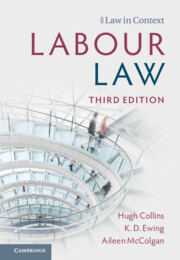Refine search
Actions for selected content:
339 results
Chapter 9 - Twenty Questions about Employment Testing Bias and Unfairness in Greece
-
-
- Book:
- Global Perspectives on the Definition, Assessment, and Reduction of Bias and Unfairness in Employment Testing
- Published online:
- 04 November 2025
- Print publication:
- 20 November 2025, pp 184-198
-
- Chapter
- Export citation
Chapter 15 - Twenty Questions about Employment Testing Bias and Unfairness in Nigeria
-
-
- Book:
- Global Perspectives on the Definition, Assessment, and Reduction of Bias and Unfairness in Employment Testing
- Published online:
- 04 November 2025
- Print publication:
- 20 November 2025, pp 304-316
-
- Chapter
- Export citation

China for Africa's Industrialization?
-
- Published online:
- 15 November 2025
- Print publication:
- 04 December 2025
-
- Element
-
- You have access
- Open access
- HTML
- Export citation
2 - Politics of Growth and Distribution
- from Part I - Politics at the Apex
-
- Book:
- Democracy and Inequality in India
- Published online:
- 11 October 2025
- Print publication:
- 30 October 2025, pp 64-92
-
- Chapter
- Export citation
Gendered adulthood trajectories and extended working lives across liberal regime countries
-
- Journal:
- Ageing & Society , First View
- Published online by Cambridge University Press:
- 17 October 2025, pp. 1-29
-
- Article
-
- You have access
- Open access
- HTML
- Export citation
Healthcare for individuals with schizophrenia in Taiwan: 10-year national trend analysis
-
- Journal:
- BJPsych Open / Volume 11 / Issue 6 / November 2025
- Published online by Cambridge University Press:
- 13 October 2025, e244
-
- Article
-
- You have access
- Open access
- HTML
- Export citation
6 - Best-Practice Principles for Copyright Reversion Mechanisms
-
- Book:
- Copyright Reversion
- Published online:
- 19 September 2025
- Print publication:
- 09 October 2025, pp 149-174
-
- Chapter
-
- You have access
- Open access
- HTML
- Export citation

Labour Law
-
- Published online:
- 02 October 2025
- Print publication:
- 20 November 2025
-
- Textbook
- Export citation
3 - Wealth
-
- Book:
- Building Social Mobility
- Published online:
- 15 September 2025
- Print publication:
- 02 October 2025, pp 64-89
-
- Chapter
- Export citation
Documenting the profession: Recording historic access and retention issues for women in UK archaeology
-
- Journal:
- Archaeological Dialogues / Volume 31 / Issue 1 / June 2024
- Published online by Cambridge University Press:
- 26 September 2025, pp. 76-100
-
- Article
-
- You have access
- Open access
- HTML
- Export citation
Food insecurity and employment income: considerations regarding gender inequalities
-
- Journal:
- Public Health Nutrition / Accepted manuscript
- Published online by Cambridge University Press:
- 25 September 2025, pp. 1-23
-
- Article
-
- You have access
- Open access
- Export citation
Extreme climatic event shocks and employment: empirical evidence from Chinese firms
-
- Journal:
- Environment and Development Economics , First View
- Published online by Cambridge University Press:
- 02 September 2025, pp. 1-29
-
- Article
- Export citation
To work or not to work: Women’s Employment in the Slums of Kolkata, India
- Part of
-
- Journal:
- The Economic and Labour Relations Review ,
- Published online by Cambridge University Press:
- 01 September 2025, pp. 1-22
-
- Article
- Export citation
Making Violators: Employers and African Workers in Colonial Dakar, 1918–43
-
- Journal:
- The Journal of African History / Volume 66 / 2025
- Published online by Cambridge University Press:
- 27 August 2025, e9
-
- Article
-
- You have access
- Open access
- HTML
- Export citation
A dismantling study of comprehensive cognitive remediation for improving employment outcomes: what is the role of computer cognitive training?
-
- Journal:
- Psychological Medicine / Volume 55 / 2025
- Published online by Cambridge University Press:
- 22 July 2025, e208
-
- Article
-
- You have access
- Open access
- HTML
- Export citation
Chapter 8 - Isolation, Indifference and Suspicion
-
- Book:
- Emigrant Soldiers
- Published online:
- 05 June 2025
- Print publication:
- 26 June 2025, pp 165-184
-
- Chapter
- Export citation
1 - Food Security and the ‘Total Ecology’ of Glasshouse Agrifood Value Chains
-
- Book:
- Fields of Glass
- Published online:
- 16 June 2025
- Print publication:
- 19 June 2025, pp 1-14
-
- Chapter
- Export citation

Fields of Glass
- Labour Regimes, Techno-Science and Biopolitics in Agrifood Value Chains
-
- Published online:
- 16 June 2025
- Print publication:
- 19 June 2025
3 - Education and the 100-Year Life
- from Part I - Implications across the Legal System
-
-
- Book:
- Law and the 100-Year Life
- Published online:
- 13 May 2025
- Print publication:
- 29 May 2025, pp 39-51
-
- Chapter
-
- You have access
- Open access
- HTML
- Export citation
Widening inclusion: A discrete choice experiment of job preferences of disabled people
-
- Journal:
- The Economic and Labour Relations Review / Volume 36 / Issue 1 / March 2025
- Published online by Cambridge University Press:
- 23 May 2025, pp. 234-256
-
- Article
-
- You have access
- Open access
- HTML
- Export citation
